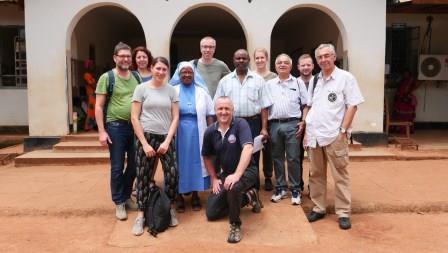TANZANIA 2 0 1 9

Austrian-UK-Slovenian
“Hernia International” Team
Mission in
Korogwe, November 11th-16th 2019
Korogwe Hernia International (HI) missions have a history – we were already the 12th HI-team to this town in the Tanga region. It consisted of 9 members: 3 surgeons, 2 anaesthesiologists, 1 radiologist, 1 medical student, 2 nurse anaesthetists (one of them with additional skills in repairing medical devices).
Invitation from Dr. Avelina Temba and Korogwe hospital and the mutual trust within the team from last year was spontaneously leading towards another mission here. Competent anaesthesia team from Feldkirch, Vorarlberg, Austria (Dr. Wirnsperger, Dr. Lienhart, nurses Sarah Bertsch, Daniel Döwa) was a call for a strong surgical part (Mr. Shambhu, Prof. Omejc, Dr. Gorjanc). The majority of the team came together in Triniti Hotel close to Dar es Salaam airport. Shambu came to Momella Village in the north after my 1st Mission there. We travelled to Korogwe from different parts of Tansania. Due to much better roads than in the past we arrived to hospital at the same time after 6-7 hours drive.
Checking patients for surgery was the first task on Sunday evening and we were able to write operating programme for 3 days already, including 2-3 pediatric cases every day. The youngest patient with a big inguinoscrotal hernia was just over 1 year old., the oldest patient had 82 years.
Already familiar team members of Korogwe general hospital were very motivated and the turnover of the patients was fluent. We were not used to take a lunch break but rather stop earlier in the evening after finishing 5-6 cases per table, finishing the day with surgery in HIV positive patients. Local doctors (dr. Ahmed, dr. Tedi, dr. Heri) assisted and also performed a decent amount of hernia repairs under our assistance in order to get more and more independent in modern hernia surgery.
Parallel operations on 3 tables, including stopping theatre 3 occasionally for cesareans (performed by local doctors), enabled 79 procedures on 65 patients in 5 days.
The presence of an experienced radiologist again turned out to be a very reasonable decision. Dr. Marija Jekovec took this time a portable ultrasound machine with her and performed 95 US-exams, including in OB-GYN and on our surgical patients. Daniel repaired 2 anaesthesia machines, 2 monitors and 1 oxygen concentrator. Consider taking a specialist like him on other missions as well. Having a motivated medical student Franziska Ganster with us turned out to be a very good idea, because she took care of small things that we tended to forget and was also learning by assisting to both surgeons and anaesthesists.
Good work in the hospital was also possible because we were accommodated well in the recently built Korogwe Executive Lodge. Very comfortable rooms and a restaurant with tasty breakfast and dinners enabled us to restart our work fresh and enthusiastic.
Korogwe hospital is definetelly ready to host new hernia missions in the future, according to invitation of director dr. Michael and sister dr. Avelina. They get every year new young GPs and doctors to assist and learn from experts. Anyway, there is a question if they need HI missions as hard as 12 years ago. Definetelly there are hernia patients, that they can manage by themselves. But among them, there are cases every year that present a big challenge even to very experienced hernia specialists.
Among 65 patients (with 79 procedures), we operated on 14 children (21%) and 51 adults (79%). 14 patiens (21%) were female. Sixteen patients (24%) had umbilical hernia>1cm and suture repair (direct closure or Mayo repair) was performed in all children with this diagnosis and underlay or sublay mesh repair in adults. The most frequent diagnosis was inguinal hernia (33 pts, 51%), of course. In inguinals in children, Mitchell-Banks repair with fascial suture was performed; in teenagers and young adults Shouldice procedure and Lichtenstein with LDPE mesh were performed. In a re-recurrent hernia in 1 old patient and in 1 adult with cryptorhidism orchidectomies were performed. In incisional and epigastric hernias (8pts, 12%). Other diagnoses were hydrocaele (13 pts, 20%), where Jabouley`s procedure was performed. Additional procedures as rectus diastasis combined with umbilical hernia were performed in some patients. We drained big incisonals, scrotals and some hydrocaeles with suction, corrugated and/or penrose drains. Our anaesthesia team also helped in CPR of 2 newborns after cesarean sections.
Due to an expert anaesthesia team (many times anaesthesia was performed by locals under their supervision) 20 general anaesthesias with ET-tube or LMA were performed, 44 pts received spinal anaesthesias and 2 procedures were done in local anaesthesia. All pediatric cases received additional caudal blocks for postoperative analgesia.
We felt privileged for having no complications which we contribute to not overcrowded programme. We also took enough time for every single procedure, without any hurrying. Last by not least, sister Avelinas prayers were accompanying us always during the whole fulfilling week.
Team Members:

Prof. Dr. Mirko Omejc – consultant surgeon, Ljubljana, Slovenia
Mr. Shambu Narayan Nadav – consultant surgeon, Oban, Scottland, UK
Dr. Jurij Gorjanc-consultant surgeon, team leader, Austria; Slovenia
Dr. Michael Wirnsperger-consultant anaesthesiologist, Feldkirch, Austria
Dr. Hannes Lienhart – consultant anaesthesiologist, Feldkirch, Austria
Dr. Marija Jekovec – consultant radiologist, Ljubljana, Slovenia
Sarah Bertsch – anaesthesia nurse, Feldkirch, Austria
Daniel Döwa, anaesthesia nurse, Feldkirch, Austria
Franziska Ganster, medical student, Munich, Germany
Our sponsors:
Kirurgija Bitenc
Splosna bolnisnica / General Hospital Slovenj Gradec
Implantoloski institut / Implant Institute
University clinical centre Ljubljana
Medical center Gorjanc
Hospital of St. John of God St. Veit/Glan

